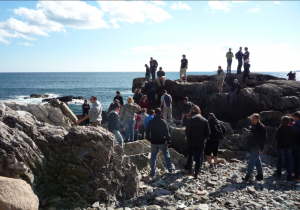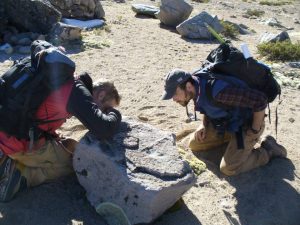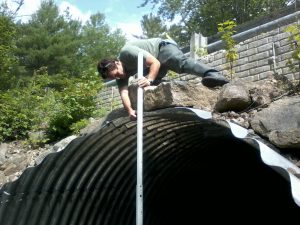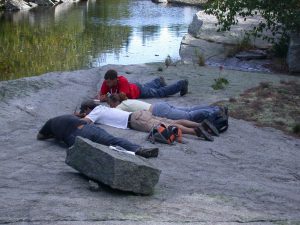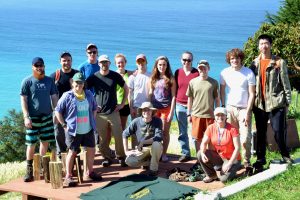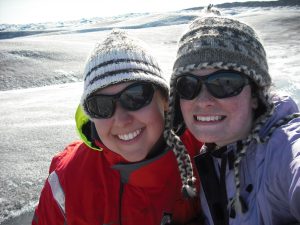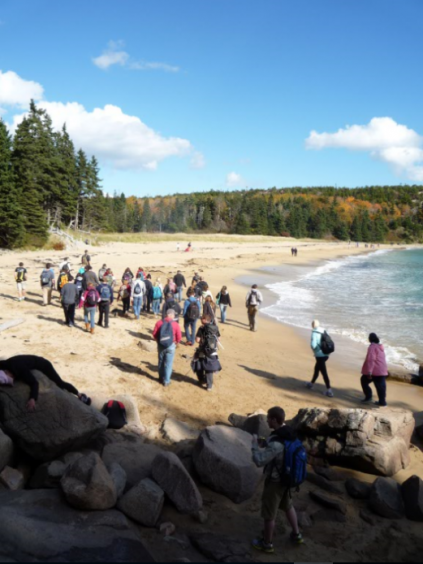Tentative Course Schedule
We teach many of our 300- and 400-level courses every other year, so you will need to look forward over your entire academic plan as you schedule courses each year. Course offerings do vary semester to semester from what is listed here depending on demand and faculty availability, but this is a general guide that we follow as closely as possible. Please check with other departments regarding their planned schedules.
Fall Every
Fall Even
Fall Odd
Spring Every
Spring Even
Spring Odd
Summer
Variable
Fall of every year
ELH 117 – First Year Success Seminar
ERS 101 – Introduction to Earth Sciences
ERS 102 – Environmental Geology of Maine
ERS 103 – Dynamic Earth
ERS 107 – Energy, Environment, and Climate
ERS 121 – Humans and Global Change
ERS 152 – Earth’s Changing Climate
ERS 200 – Earth Systems
ERS 301 – Earth Science and Climate Geomatics
ERS 320 – Research Seminar
ERS 425 – How to Build a Habitable Planet; also cross-listed as 525
ERS 441 – Glaciers and Our Landscape; also cross-listed as 541
ERS 525 – How to Build a Habitable Planet; also cross-listed as 425
ERS 541 – Glaciers and Our Landscape; also cross-listed as 441
ERS 542 – Atmosphere, Ocean, Ice, and Climate Change
ERS 315 – Principles of Sedimentology and Stratigraphy
ERS 420 – Computer Scripting for Data Analysis
ERS 433 – Igneous and Metamorphic Petrology
ERS 316 – Structural Geology
ERS 361 – Principles of Geomorphology
ERS 480 – Introduction to Hydrogeology; also cross-listed as 580
ERS 553 – Quaternary Stratigraphic Record
ERS 580 – Introduction to Hydrogeology; also cross-listed as 480
ERS 101 – Introduction to Geology
ERS 102 – Environmental Geology of Maine
ERS 103 – Dynamic Earth
ERS 108 – Beaches and Coasts
ERS 201 – Global Environmental Change
ERS 350 – Fresh-Water Flow
ERS 410 – Sea to Sky Field Experience
ERS 503 -Graduate Research Seminar in ECS
ERS 581 – Proposal Writing
ERS 602-1 – ECS Seminar
ERS 317 – Introduction to Geophysics
ERS 323 – Extreme Weather
ERS 330 – Earth Materials
ERS 340 – Economic Geology
ERS 460 – Marine Geology; also cross-listed with 560
ERS 521 – Low Temperature-Pressure Geochem
ERS 560 – Marine Geology; also cross-listed with 460
ERS 240 – The Atmosphere
ERS 312 – Geochemistry
ERS 319 – Geohazards and Humans
ERS 401 – Paleoceanography; also cross-listed with 501
ERS 444 – Introduction to Glaciology; also cross-listed with 544
ERS 451 – Tectonics
ERS 501 – Paleoceanography; also cross-listed with 401
ERS 527 – Isotope Geology
ERS 544 – Introduction to Glaciology; also cross-listed with 444
ERS 103 – Dynamic Earth
ERS 107 – Energy, Environment, and Climate
Variable Courses – Any Semester
ERS 321 – Problems in Earth and Climate Sciences
ERS 555 – Microstructural Processes
ERS 579 – Topics in Structure and Petrology
ERS 588 – Topics in Applied Hydrogeology
ERS 602 – Selected Study in Geology; typically several courses of varying topics are offered.
Course Descriptions
Level: 100 | 200 | 300 | 400 | 500 | 600
ERS 101 – Introduction to Earth Sciences
A study of earth materials and processes, including their impact on humans. Topics include plate tectonics, mineralogy, formation of igneous, metamorphic and sedimentary rocks, geologic time, weathering and soil formation, evolution of mountain belts, earthquakes, climate change, water cycle, and surface processes. This course may include field trips outside of class time. Laboratory work includes the study of rocks, minerals, topographic maps, and aerial photographs.
General Education Requirements: Lab in the Basic or Applied Sciences
Course Typically Offered: Fall, Spring
Credits: 4
ERS 102 – Environmental Geology of Maine
Environmental Geology explores the interaction of humans with the Earth’s systems. The course begins with discussions of earth materials and human population dynamics. The science underlying geologic hazards (earthquakes, floods, landslides, etc.) is described and the interaction between geologic hazards and humans is explored. Human impacts on earth systems are identified and evaluated with a focus on pollution and climate change. Sources of energy used by humans and the associated environmental consequences of different energy sources are discussed. May include a one day field trip.
General Education Requirements: Laboratory in the Basic or Applied Sciences and Population and the Environment
Course Typically Offered: Fall & Spring
Credits: 4
ERS 103 – Dynamic Earth
Explores how Earth’s dynamic processes interact with humans by evaluating: the interplay between Earth’s interior, hydrosphere, biosphere and atmosphere; the effects and underlying causes of natural hazards such as earthquakes, volcanic eruptions, tidal waves and global warming; Earth’s economic and energy resources how they form and how long they will last; and the global environment and how best to interact with it. Lec 3.
General Education Requirements: Applications of Scientific Knowledge and Population and the Environment
Course Typically Offered: Fall, Spring, Summer
Credits: 3
ERS 107 – Energy, Environment, and ClimateExplores the Earth Science concepts that underlie energy, energy sources, the environmental impacts of energy use, and the role of energy in climate. We will consider the ways in which society interacts with and extracts energy from the Earth System, the energy balance of Earth, the climate and environmental implications of energy use, and gain an understanding of renewable and non-renewable energy sources.
General Education Requirements: Applications of Scientific Knowledge and Quantitative Literacy
Course Typically Offered: Fall, Spring, and Summer
Credits: 3
ERS 108 – Beaches and Coasts
An introduction to coastal landforms, including beaches, salt marshes, tidal flats and sea cliffs, their origins, global distribution, and associated nearshore processes. Human impacts to the coastal zone, including coastal erosion, land loss and management, and human responses to sea-level change are considered. Course may have field trips during class time and a one day field trip. (This course is identical to SMS 108.)
General Education Requirements: Applications of Scientific Knowledge and Population and the Environment
Course Typically Offered: Spring
Credits: 3
ERS 121 – Humans and Global Change
Explores how Earth’s climate system works and how past environmental changes affected humans on time scales ranging from interannual to hundreds of thousands of years. Topics will range from the development of agriculture at the beginning of the current interglaciation to how humans are now changing global climate through the addition of greenhouses gases to the atmosphere.
General Education Requirements: Population and the Environment
Course Typically Offered: Fall
Credits: 3
ERS 152 – Earth’s Changing Climate
Earth harbors a climate that is unique in the solar system, with its ability to sustain liquid water and support life. The geologic record bears witness to spectacular climate changes in the past, the most recent of which heralded the emergence of a complex, globally interconnected human society. Today humans are influencing the climate system in potentially unprecedented ways. The purpose of this course is to understand and evaluate the scientific basis of Earth’s climate and past, present, and future change within the climate system, and to provide scientific context for a warming world.
General Education Requirements: Quantitative Literacy and Application of Scientific Knowledge
Course Typically Offered: Fall
Credits: 3
ERS 200 – Earth Systems
A survey of dynamic topics in earth sciences, emphasizing active participation in on-going faculty research in topics such as: global climate change, changing sea levels, geochemical cycles, plate tectonics and mountain building, and the geological evolution of the northern Appalachians. Multiple field trips; at least one a weekend. Lec 3, Lab 3.
General Education Requirements: Writing Intensive and Lab in the Basic or Applied Sciences
Prerequisites: Any 100-level UMaine Earth Sciences course.
Course Typically Offered: Fall
Credits: 4
ERS 201 – Global Environmental Change
Examines the physical and chemical interactions among the primary systems operating at the Earth’s surface (atmosphere, hydrosphere, cryosphere, biosphere, and lithosphere) on various timescales throughout geologic history. We will consider internal and external forces that have shaped environmental evolution, including the role of humans in recent geochemical and climatic change. During lecture and laboratory sessions, our goals are to develop critical thinking skills and a scientific approach to the complex array of feedbacks operating at the Earth’s surface, as well as an appreciation for how past environmental change informs current societal issues. Course will include field trips during class hours and may include weekends.
General Education Requirements: Lab in the Basic or Applied Sciences and Population and the Environment
Prerequisites: Any 100-level ERS course.
Course Typically Offered: Spring
Credits: 4
ERS 240 – The AtmosphereThe nature of planetary atmospheres, physical processes in the atmosphere, clouds and precipitation, global climate, seasons, natural and anthropogenic climate change, forecasting of storms. Lec 3, Lab 2.
General Education Requirements: Laboratory in the Basic or Applied Sciences
Course Typically Offered: Spring, Odd Years
Credits: 4
ERS 301 – Earth and Climate Science GeomaticsThis course will provide an introduction to the collection, display, manipulation and management of geospatial information. The focus will be on modern tools, techniques and methodologies commonly used by earth and environmental scientists. The course will be divided into surveying and mapping (including GPS), satellite remote sensing, and geographical information systems (GIS). Lec. 2.5 hr, Lab 3hr.
Prerequisites: Any ERS 100 level course or SMS 108 and MAT 111 or a score of 30 or higher on the Math Placement Exam or permission of instructors.
Course Typically Offered: Fall
Credits: 4
ERS 312 – Geochemistry
Introduction to the field of geochemistry, from Earth formation to modern processes in the deep Earth and at the surface. This course will investigate the chemistry of many Earth materials, including rocks, soils, surface and ground waters, and oceans. Course may include weekend field trips. Lec 3, Lab 3
General Education Requirements:
Prerequisites: CHY 121 & 123, and any 100 level ERS course.
Course Typically Offered: Spring, Odd Years
Credits: 4
ERS 315 – Principles of Sedimentology and Stratigraphy
Basic concepts and techniques of stratigraphy and sedimentation. Field trips to local environments and outcrops. Laboratories emphasize practical analytical techniques of sedimentology, petrography of sedimentary rocks in hand specimens and thin section, and modern stratigraphic approaches. Lec 3, Lab 3.
General Education Requirements: Writing Intensive
Prerequisites: Any 100 level ERS course.
Course Typically Offered: Fall Even Years
Credits: 4
ERS 316 – Structural Geology
Explores the principles of structural geology, with emphasis on the geometry, kinematics and dynamics of Earth deformation. Includes several field trips with the aim of integrating field observations and theory. Lec 2, Lab 3. Course may have field trips during class times with the aim of integrating field observations and theory.
General Education Requirements: Writing Intensive
Prerequisites: ERS 200.
Course Typically Offered: Fall, Odd Years
Credits: 4
ERS 317 – Introduction to Geophysics
Introduction to geophysical studies and global geodynamics. Seismological, gravity, magnetic, electrical and geothermal studies of the Earth’s lithosphere and cryosphere are emphasized in integrated class, field and laboratory exercises. Course problem solving requires spread sheeting and numerical modeling applications using available personal computers.
Prerequisites: MAT 116 or MAT 126 & PHY 111 or 121 and any 100 level ERS course.
Course Typically Offered: Spring, Even Years
Credits: 4
ERS 319 – Geohazards and Humans
Geohazards and Humans will introduce the scientific principles necessary to understand the underlying causes of the most devastating natural disasters on Earth. Students will learn how to apply modern geological concepts and theories to identify drivers of major geological hazards and reduce their impacts. It is designed for students who major in the geosciences but will also benefit students majoring in environmental science, engineering, public policy and business. A primary goal is to translate a working knowledge of the science of natural hazards into strong critical-thinking and problem-solving skills to prepare students to work with geohazards in their future careers. To meet this goal, the course objectives are to demonstrate the use of geological methods and techniques to study geological hazards, and introduce tools that help to mitigate the impact of these events on humans. Students will learn about established and emerging approaches for reducing the impact of volcanic eruptions, earthquakes, tsunamis, landslides, extra-terrestrial impacts, shifts in climate and anthropogenic pollutants on humans and the global economy.
General Education Requirements: Science Applications and Population and Environment
Prerequisites: Any 100-level Earth Science course or by permission
Course Typically Offered: Spring
Credits: 3
ERS 320 – Research Seminar in Earth and Climate Sciences
Research seminar course of students with junior or senior standing. Students will attend research presentations by School of Earth and Climate Sciences faculty or graduate students and write short reviews of these presentations with the goals of increasing student understanding and awareness of the role of research in earth and climate sciences and strengthening students’ writing skills.
Prerequisites: ERS 200 and ERS 201 and Junior or Senior Standing
Course Typically Offered: Fall
Credits: 1
ERS 321 – Problems in Earth and Climate Sciences
Students conduct an original investigation and report findings. May not normally be used as a required geology elective. May be repeated for credit.
Prerequisites: Permission of instructor.
Course Typically Offered: Variable
Credits: 1-4
ERS 323 – Extreme Weather
Extreme weather is analyzed in terms of its physical basis as well as historical, economic and human consequences. Emphasis is placed on the interplay between technological advances, the evolution of meteorology as a science, and the impacts of extreme weather (winter storms, severe thunderstorms, tornados, tropical storms, El Nino, floods, droughts, heatwaves, cold waves). Recommended: ERS 121 or ERS 240
General Education Requirements: Quantitative Literacy and Population and Environment
Course Typically Offered: Spring, Even Years
Credits: 3
ERS 330 – Earth Materials
Examination of fundamental aspects of the materials that record Earth history and the processes that shape the planet. Through a combination of lectures, laboratory sessions, and other active-learning exercises, we explore how minerals form, their structure and composition, and their physical and chemical properties. Through discussions and presentations, we explore minerals in the context of the rocks in which they are found, with the aim of gaining a greater understanding of physical and chemical makeup of the Earth. Throughout the course, we relate mineralogy to geologic processes and other fields of Earth Science. Course may include weekend field trips.
Prerequisites: ERS 200 or ERS 201; CHY 121 and MAT 126 recommended.
Course Typically Offered: Spring, Even Years
Credits: 4
ERS 340 – Economic Geology
This course examines the geological characteristics of metallic and industrial mineral deposits, the geological environments and processes responsible for their genesis, the methods used in their discovery and extraction, and the challenges of environmentally responsible reclamation of extraction sites.
Prerequisites: ERS 330 or permission.
Course Typically Offered: Spring, Odd Years
Credits: 3
ERS 350 – Fresh-Water Flow
Focuses on characterizing fresh-water hydrologic systems (Lakes, Rivers, ground water, etc.) and the fluxes of water between these reservoirs. Rates of precipitation, evaporation, channelized flow, overland flow, and infiltration are calculated and used to assess watershed hydrology. Course may include weekend field trips.
Prerequisites: MAT 122 or a passing score on UM Math Placement Exam #3.
Course Typically Offered: Spring
Credits: 3
ERS 361 – The Principles of Geomorphology
Focuses on the shapes, dimensions, and dynamics of landforms on Earth. The material covered will provide an introductory understanding of process mechanics and their relation to the genesis and alteration of landforms in varied settings and over a range of scales. Topics covered will include general background on the discipline of geomorphology, internal and climate forces associated with earth surface systems, chemical and physical weathering, drainage basins, fluvial systems, wind generated landforms, glacial processes, karst landscapes, and coastal environments. The course approach will provide attention to landform ontologies, measurement techniques, and analytical frameworks necessary to quantify earth surface measurement and observations. Two one-day weekend field trips may be scheduled during the semester.
Prerequisites: ERS 200 and ERS 201
Course Typically Offered: Fall, Odd Years
Credits: 3
ERS 401 – Paleoceanography
The ocean plays a central role in regulating climate and supporting life on our planet, and it has not always operated as it does today. Throughout Earth history, the ocean has undergone dramatic changes in circulation, temperature, chemical composition, and more. In this course, students will explore our ocean’s dynamic past, which provides insight into its present and future behavior. We will discuss key research techniques, major discoveries, and emerging frontiers in the field of paleoceanography (the study of the global ocean’s circulation, chemistry, biology, and geology through geologic time). Students will read and discuss key research articles each week that complement lecture material. They will also work with both modern and paleo datasets to enhance their skills and deepen their understanding of how scientists infer past ocean conditions from geologic archives. ERS 401 and ERS 501 cannot both be taken for credit.
Prerequisites: Any 100 level ERS course.
Course Typically Offered: Spring, Odd Years
Credits: 3
ERS 410 – Sea to Sky Field Experience
Many critical processes in the Earth and climate sciences occur at interfaces among the atmosphere, cryosphere, hydrosphere, biosphere, oceans, solid earth, and society. Using an interdisciplinary systems-based approach, as well as the ability to make direct observations, are essential to understanding these processes. ERS 410 will visit a region where a wide range of environments – everything from open ocean (“sea”) to glaciers (“sky”) – can be experienced. During this travel study course, we will focus on a range of professional and practical skills, including global impact/local relevance research, proposal development, science planning and logistics, risk assessment and mitigation, safety, group dynamics and collaboration, field-based and remote observations, cultural knowledge, and science communication.
General Education Requirements: Capstone
Prerequisites: ERS 200 and ERS 201 or instructor permission
Course Typically Offered: Fall, Spring, Summer
Credits: 3
ERS 420 – Computer Applications in Earth Science
This course focuses on the application of a computer scripting language (Python or similar language) to interpret and analyze earth and environmental science data and processes. Students will learn to use an interpreted computer language to perform calculations, evaluate data sets, create complex graphs and simulate simple systems.
Prerequisites: MAT 116 or MAT 122
Course Typically Offered: Variable
Credits: 3
ERS 425 – How to Build a Habitable Planet
This course will take a journey through the remarkable geologic and climatic events that led to the emergence of life, an oxygen-rich atmosphere, explosions and collapses of biodiversity, waxing and waning of continental ice sheets, and ultimately a planet on which Homo Sapiens could thrive and develop civilizations unlike anything Earth has ever witnessed. We will explore the great and as-yet unsolved mysteries of Earth’s evolution with an eye toward placing our existence into the context of what it takes to build, and sustain, a habitable world. We will consider internal and external forces that have shaped environmental evolution over the planet’s history, including the role of humans in geochemical and climatic change. We will consider the geochemical proxies and isotopic geochronometers that have improved our understanding of past environments and climates. Our goals are to develop critical thinking and writing skills and a scientific approach to the complex array of feedbacks that govern the evolution of Earth’s surface and climate, as well as an appreciation for how past Earth System change can inform current human and societal issues. ERS 425 and ERS 525 cannot both be taken for credit.
Prerequisites: ERS 200 and ERS 201, or instructor permission
Course Typically Offered: Fall
Credits: 3
ERS 433 – Igneous and Metamorphic Petrology
Using field relationships, rock textures, and chemical systems, we take a qualitative and quantitative system-based approach to exploring rock-forming processes within Earth’s crust and mantle. In keeping with the fact that modern understanding of igneous and metamorphic processes requires use of microscopes and microanalysis, students will use petrographic and electron microscopes to make observation and gather data related to mineral chemistry and textures in preparation for later analysis. This course also develops aspects of scientific methodology, including classification schemes and data collection, management, and analysis. Several weekend field trips are required.
Prerequisites: ERS 330.
Course Typically Offered: Fall, Even Years
Credits: 4
ERS 441 – Glaciers and Our Landscape
Explores the nature of the ice ages, including the work of glaciers and how they shape the earth’s surface. Emphasis is on understanding the processes that resulted in the landscape and sediments we see today. Course may have field trips during class times. (ERS 441 and 541 are identical courses and cannot both be taken for degree credit.)
General Education Requirements: Population and the Environment and Writing Intensive
Prerequisites: Any 100 level ERS course or Graduate Standing
Course Typically Offered: Fall
Credits: 3
ERS 444 – Introduction to Glaciology
Glaciers and ice sheets cover a significant portion of the planet and have major impacts on surrounding Earth systems and human communities. Glaciers act as a consistent source of freshwater, they sculpt the Earth’s near surface geology, and they can influence tectonics, weather, climate, ocean and surrounding ecosystems. This course will study the life cycle of glaciers and ice sheets, the physics which influence their structure, size, movement, and their interaction with surrounding environments. This course will also explore tools and methods used to study glaciers and ice sheets through practical exercises and experiments. Methods we will explore include classic field glaciological techniques, geochemistry, geophysics, remote sensing, and numerical modeling. Note: ERS 444 and ERS 544 cannot both be taken for credit.
Prerequisites: ERS 200 or ERS 201 and MAT 116 or MAT 126 or permission of the instructor
Course Typically Offered: Spring, Odd Years
Credits: 4
ERS 451 – Tectonics
Exploration of the plate tectonic mechanisms that control and modify the first-order features of Earth’s surface. We consider how the movements of the uppermost 100-200 km of our planet creates the topographic features and patterns in the continents and oceans. One weekend field trip.
Prerequisites: Any 200-level ERS course or permission.
Course Typically Offered: Spring, Odd Years
Credits: 3
ERS 460 – Marine Geology
Topics include theories of the origin of the earth as a planet and the development of continents and ocean basins, morphology and structure of the sea floor, interpretation of geological and geophysical evidence relevant to the origin and evolution of major tectonic features of oceans. Students may not receive credit for both ERS 460 and ERS 560.
Prerequisites: Any 100 level ERS course.
Course Typically Offered: Spring, Even
Credits: 3.0
ERS 480 – Introduction to Hydrogeology
The role of groundwater in geologic and water supply processes including: the hydrologic cycle, groundwater interaction with surface water, groundwater flow and transport equations, aquifer characterization, chemistry of groundwater, and groundwater as a geologic agent. ERS 480 and ERS 580 cannot both be taken for credit.
Prerequisites: Any 100 level ERS course and MAT 116 or MAT 126.
Course Typically Offered: Fall, Odd Years
Credits: 3
ERS 498 – Undergraduate Thesis
Original research in geological sciences. The research problem must be identified prior to the start of the senior year and may be of an experimental, empirical or theoretical approach. A committee of three or more faculty will supervise the thesis and its defense.
Prerequisites: Senior standing.
Course Typically Offered: Fall, Spring, Summer
Credits: 3
ERS 499 – Field Experience in Earth and Climate Sciences
Students will attend a four- to six-week earth or climate science field camp or engage in equivalent field-based research activities. The experience (a) draws together the various threads of the School’s undergraduate program, (b) typifies the work of professionals within Earth and Climate Sciences, (c) develops problem-solving skills while working within a natural system, and (d) develops spatial cognition and reasoning.
General Education Requirements: Capstone
Prerequisites: Senior standing and permission
Course Typically Offered: Fall, Spring and Summer
Credits: 4-6
ERS 501 – Paleoceanography
The ocean plays a central role in regulating climate and supporting life on our planet, and it has not always operated as it does today. Throughout Earth history, the ocean has undergone dramatic changes in circulation, temperature, chemical composition, and more. In this course, students will explore our ocean’s dynamic past, which provides insight into its present and future behavior. We will discuss key research techniques, major discoveries, and emerging frontiers in the field of paleoceanography (the study of the global ocean’s circulation, chemistry, biology, and geology through geologic time). Students will read and discuss key research articles each week that complement lecture material. They will also work with both modern and paleo datasets to enhance their skills and deepen their understanding of how scientists infer past ocean conditions from geologic archives. ERS 401 and ERS 501 cannot both be taken for credit.
Prerequisites: Any 100 level ERS course.
Credits: 3
ERS 521 – Low Temperature-Pressure Geochemistry
Algebraic and graphical analysis of water-mineral interactions at earth surface conditions. Topics include congruent and incongruent solubility, complexing, redox reactions, ion exchange, coprecipitation, chemical precipitation, evaporation, and diffusion.
Prerequisites & Notes: CHY 121, MAT 126.
Credits: 3
ERS 525 – How to Build a Habitable Planet
This course will take a journey through the remarkable geologic and climatic events that led to the emergence of life, an oxygen-rich atmosphere, explosions and collapses of biodiversity, waxing and waning of continental ice sheets, and ultimately a planet on which Homo Sapiens could thrive and develop civilizations unlike anything Earth has ever witnessed. We will explore the great and as-yet unsolved mysteries of Earth’s evolution with an eye toward placing our existence into the context of what it takes to build, and sustain, a habitable world. We will consider internal and external forces that have shaped environmental evolution over the planet’s history, including the role of humans in geochemical and climatic change. We will consider the geochemical proxies and isotopic geochronometers that have improved our understanding of past environments and climates. Our goals are to develop critical thinking and writing skills and a scientific approach to the complex array of feedbacks that govern the evolution of Earth’s surface and climate, as well as an appreciation for how past Earth System change can inform current human and societal issues.
ERS 425 and ERS 525 cannot both be taken for credit.
ERS 527 – Isotope Geology
Theory of variations in the relative abundances of naturally occurring radioactive and stable isotopes. Applications will emphasize the use of isotopic tracers in studies of petrogenesis, geochronology, paleoceanography and paleoecology.
Prerequisites & Notes: ERS 333 or permission.
Credits: 3
ERS 541 – Glaciers and Our Landscape
Explores the nature of the ice ages, including the work of glaciers and how they shape the earth’s surface. Emphasis is on understanding the processes that resulted in the landscape and sediments we see today. Required field trips. (ERS 441 and 541 are identical courses and cannot both be taken for degree credit.)
General Education Requirements: Satisfies the General Education Population and the Environment and Writing Intensive Requirements.
Prerequisites: Any 100 level ERS course or Graduate Standing
Credits: 3
ERS 542 – Atmosphere, Ocean, Ice, and Climatic Change
Designed to introduce graduate students to the main components of Earth’s climate system. Topics include: Heating of the earth by solar radiation, Radiation balance, Composition and circulation of the atmosphere and ocean. Geographic distribution and motion of ice. Feedbacks between components of the climate system. Past changes in the radiative forcing, atmosphere, ocean, and ice on Earth. Climate change on time scales ranging from years to millions of years.
Prerequisites & Notes: ERS 541 or permission.
Credits: 3
ERS 544 – Introduction to Glaciology
Glaciers and ice sheets cover a significant portion of the planet and have major impacts on surrounding Earth systems and human communities. Glaciers act as a consistent source of freshwater, they sculpt the Earth’s near surface geology, and they can influence tectonics, weather, climate, ocean and surrounding ecosystems. This course will study the life cycle of glaciers and ice sheets, the physics which influence their structure, size, movement, and their interaction with surrounding environments. This course will also explore tools and methods used to study glaciers and ice sheets through practical exercises and experiments. Methods we will explore include classic field glaciological techniques, geochemistry, geophysics, remote sensing, and numerical modeling.
Perequisites: ERS 200 or ERS 201 and MAT 116 or MAT 126 or permission of the instructor
Credits: 4 with lab
ERS 553 – The Quaternary Stratigraphic Record
Explores cutting-edge hypotheses for Quaternary climate change. Presents records used to develop and test these hypotheses.
Prerequisite: Permission or graduate major in Earth and Climate Sciences
Credits: 3
ERS 555 – Microstructural Processes
An examination of deformation mechanisms and resulting microstructures in rocks, use of prophyroblast-matrix relationships to determine timing relations between deformation and metamorphism and interpretation of kinematic indicators that form during rock deformation. Lec 2, Lab 2.
Prerequisites & Notes: ERS 316, ERS433
Credits: 3
ERS 560 – Marine Geology
Topics include theories of the origin of the earth as a planet and the development of continents and ocean basins, morphology and structure of the sea floor, interpretation of geological and geophysical evidence relevant to the origin and evolution of major tectonic features of oceans. Students may not receive credit for both ERS 460 and ERS 560.
Prerequisites: Any 100 level ERS course.
Course Typically Offered: Spring, Even
Credits: 3.0
ERS 579 – Topics in Structure and Petrology
Explores topics related to (1) fundamental concepts and modern applications of structural geology, rheology, microstructures, and/or igneous and metamorphic petrology and (2) developing skills at extracting from and synthesizing the literature. Topics vary from year to year. May be repeated for credit. Lec 2, Lab 2.
Credits: 3
ERS 580 – Introduction to Hydrogeology
The role of groundwater in geologic processes: the hydrologic cycle, groundwater transport equations, chemical evolution of groundwater, and groundwater as a geologic agent. ERS 480 and ERS 580 cannot both be taken for credit.
Prerequisites & Notes: Any 100 level ERS course and MAT 126.
Credits: 3
ERS 581 – Proposal Writing
A practical course to facilitate development of research proposals. After discussion of key components, students contribute and Peer edit selected proposal elements, with the culmination of a complete proposal at the end of the semester. Can be taken multiple times for credit.
Credits: 1
ERS 588 – Topics in Applied Hydrogeology
Topics will vary and will include ground-water flow modeling, ground-water chemistry and modeling, and data analysis in hydrogeology. A discussion of the methods behind computational tools used in hydrogeology will be followed by the application of software. May be repeated for credit.
Prerequisites & Notes: COS 101, COS 102, COS 103, ERS 580 and MAT 127 or permission of instructor.
Credits: 3
ERS 602 – Selected Study in Geology II
Tutorial course. Specific topics determined by the instructor’s expertise.
Prerequisites & Notes: permission.
Credits: Ar
ERS 699 – Graduate Thesis
Research Graduate Thesis
Credits: Ar


